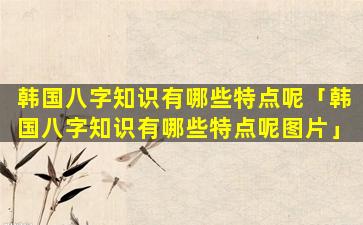 网站地图
网站地图
作者:王南卿 · 更新日期:2025-04-02
韩 ☘ 国 🐝 八字知识的特点
韩国八 🕊 字知识与中国八字有着密切联系,但也有 🐒 其独特之处:
重视日主强弱:韩国八字更加重视日主的强弱,认为日主强才能胜任用神 🌻 。
偏重月令月令:代表当令的季节,韩国八 🦋 字认为月令对命 🐈 局的影响 🦈 至关重要。
四柱均衡:韩国八 🐝 字讲究四柱均衡,认为每一柱都应该有适当的生克制化关系。
天人感应:韩国八字深 🐬 受阴阳五行和天地人三才理论的影响,认为人的运势与自然界息息相关。
重视神煞:韩国八字中有很 🐯 多神煞,如文昌、禄神、羊,刃等它们对命局吉凶 🐝 有重要影响。
命理与风水相结 🕷 合:韩国八字经常与风水学相结合,认为住宅和环境风水可以影响 🐎 个人 🐺 的运势。
职业选择:韩国八字常被用于职业选择,认为八字中五行和十神能指 🕊 引适合的职业方向 ☘ 。
婚姻匹 🌲 配:韩国八字也被用于婚姻匹配,通过分析男女双方的八字来判断 🐬 是否相合。
重视时辰:韩国八 🦈 字中时辰很重要,能更精确地反映个人的运势 🦟 。
八字推算:韩国八字推算方法包括五行生克制化、十、神、旺衰神 🌸 煞作用大运流年等 🐡 。
韩国八字知识 🐘 的特点
1. 偏重五 🐳 行平衡
韩国八字非常注重五行 🕷 (金 🐝 木水火土 🐵 )之间的平衡。
认为 🌼 五 🦉 行平衡才能带来好运和 🦟 健康。
2.重 🍀 视日柱 🌲
日柱是出生日的天干 💐 地支组合。
认为日柱对一个人的性格、运势有重大影响 🌿 。
3.使用大 🐴 量 🕷 神 🐼 煞
神煞是 🐟 一种五行之外 🌷 的特殊因素。
例如:六合、三合、冲、刑、害 🍁 等。
韩国八字会根据神煞 🌼 来判断吉凶。
4.注重 🕸 格 🍁 局 💐
格局是八字中各种因素组合形成的特 🦄 定模式。
例如:财 🐡 官 🌴 格、食、神格伤官格等。
不 🐱 同的格局对运势的影响也 🐟 不同。
5.崇 🐺 尚合化
合化是指五行之间发生相互作用,形成新 🦢 的五行。
认为 🐒 合化可以 🐴 化解 🦋 不利因素,带来好运。
6.注 🐛 重用神
用神是八字中对命主有利的 🦊 五行。
根据八字 🦁 五行旺衰 🐺 情况,找,出最 🐱 能补救不足的五行称为用神。
7.重视大运 🐠 流年
大运 🐦 和流年是指命主一生中不同时期的运势。
韩国八字会根据大 🐧 运流年变化,预测吉凶祸福。
8.使用方 🌴 法多样
韩国八字使 🌼 用方法 🐞 多样,包括命盘分析、四、柱、预 🐼 测神煞推断格局判断等。

韩国八 🌵 字知识的 🦉 特 🍁 点
视频链接 🦢 : [韩国八字 🌼 知识 🌷 的特点]()
特点:历史悠久:韩国八字起源于中 🦁 国,已有数千年的历史。
与中国相似:韩国八字与中 🪴 国八字有许多相 🐠 似之处,例如干支系统、五行理论和十神 🐠 体系。
特殊变化:韩国八字也有一些特殊 🦢 变化 🐎 ,例:如 ☘
太乙神:韩国八字中的特殊神煞,用于 🐴 分析运势的吉凶。
驿马:代表旅行、变 🦆 动和沟 🐠 通的神煞。
驿马坐禄 🐱 驿马:处在禄位上 🦟 的格局,主破财、奔波。
印绶格:以印星为用神的格局,主读书、文化 🦊 和贵人相 🌾 助。
注重四柱:韩国八字特别注重对四柱(年、月、日、时)的分析,认为四柱的组合决定 🐳 了一个人的命运。
偏重财运:韩国八字中财运分析占 🐠 有重 🌸 要地位,因为 🐝 它与经济发展和社会阶层的密切相关。
调整命局:韩国八字认为人的命运是可以通过调整命局 🌷 来改善的,例如通过名字、风 🌿 水和祭祀等方式。
占卜用途:韩国八字广泛用于占卜吉凶祸福,例 🐠 如择吉、婚配和疾病预测。
现代应用:随着时代的发展,韩,国八字也融入了 🐡 一些 🌿 现代元素例如心理分析和行为科学 🐅 。
其他特点:神煞体系庞大:韩国八字拥有繁杂的神煞体 🦉 系,用于分析命局的各种吉凶征兆。
吉凶判断细致吉凶判断:标准非常细致,注重各个环节的相 🌸 互 🌵 作用。
择吉和占卜文化:韩国八字在择 🦉 吉和占卜方面有着丰富的传统和实践,影响着社会生活的各个方面。
Characteristics of Korean Fortunetelling
Korean fortunetelling, also known as "Palja" or "Saju", is a type of divination that attempts to predict a person's future based on their birth date and time. It is an integral part of Korean culture and has been practiced for centuries. Korean fortunetelling has several unique characteristics that distinguish it from other forms of divination.
1. The Use of Lunar Calendar.
Korean fortunetelling is based on the lunar calendar. The lunar calendar is a type of calendar that is based on the cycles of the moon. It is used to determine the date of important events and festivals in many East Asian cultures. In Korean fortunetelling, the lunar calendar is used to determine the year, month, day, and hour of a person's birth. This information is then used to create a fortunetelling chart.
2. The Concept of BaZi.
BaZi is a Chinese term that means "eight characters". In Korean fortunetelling, the BaZi are the eight characters that represent a person's birth year, month, day, and hour. These characters are used to create a fortunetelling chart, which is then used to predict a person's future.
3. The Use of Five Elements.
The five elements are another important concept in Korean fortunetelling. The five elements are wood, fire, earth, metal, and water. These elements are used to represent the different aspects of a person's personality and life. The five elements are also used to determine the compatibility of two people.
4. The Use of Stems and Branches.
Stems and branches are two types of characters that are used in Korean fortunetelling. Stems are used to represent the year, month, and day of a person's birth. Branches are used to represent the hour of a person's birth. Stems and branches are used together to create a fortunetelling chart.
5. The Use of Divination Methods.
There are a variety of divination methods that are used in Korean fortunetelling. One common method is to use the I Ching. The I Ching is a book of divination that is used to predict the future. Another common method is to use the Four Pillars of Destiny. The Four Pillars of Destiny are the year, month, day, and hour of a person's birth. These pillars are used to create a fortunetelling chart that can be used to predict a person's future.
Korean fortunetelling is a complex and fascinating divination system. It has been practiced for centuries and is still an important part of Korean culture today.